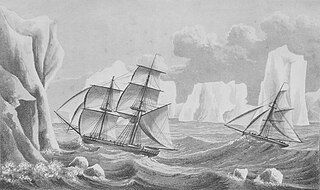
The history of Antarctica emerges from early Western theories of a vast continent, known as Terra Australis, believed to exist in the far south of the globe. The term Antarctic, referring to the opposite of the Arctic Circle, was coined by Marinus of Tyre in the 2nd century AD.
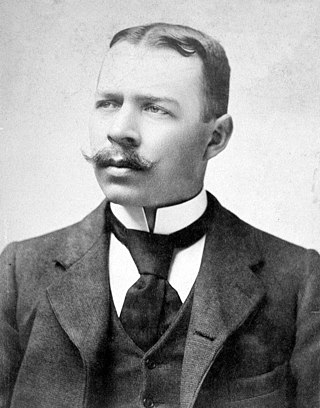
Carsten Egeberg Borchgrevink was a Norwegian polar explorer and a pioneer of Antarctic travel. He inspired Sir Robert Falcon Scott, Sir Ernest Shackleton, Roald Amundsen, and others associated with the Heroic Age of Antarctic Exploration.

Terra Nova was a whaler and polar expedition ship. The ship is best known for carrying the 1910 British Antarctic Expedition, Robert Falcon Scott's last expedition.

SS Newfoundland was a wooden-hulled brigantine and steamship that was built in 1872 and wrecked in 1916. She was a cargo ship, and for part of her career she was a sealing ship. In 1916 she was renamed Samuel Blandford.
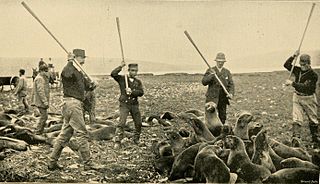
Seal hunting, or sealing, is the personal or commercial hunting of seals. Seal hunting is currently practiced in nine countries: United States, Canada, Namibia, Denmark, Iceland, Norway, Russia, Finland and Sweden. Most of the world's seal hunting takes place in Canada and Greenland.

USS Bear was a dual steam-powered and sailing ship built with six-inch (15.2 cm)-thick sides which had a long life in various cold-water and ice-filled environments. She was a forerunner of modern icebreakers and had a diverse service life. According to the United States Coast Guard official website, Bear is described as "probably the most famous ship in the history of the Coast Guard."
Abram Kean was a sealing captain and politician from Flowers Island, Newfoundland. He was famous for his success in sealing, with capturing over a million pelts, and infamous for his role in sending 78 men to their deaths in the 1914 Newfoundland Sealing Disaster.
SS Viking was a wooden-hulled sealing ship made famous by its role in the 1931 film The Viking. During her use in the seal hunt in Newfoundland, the ship was twice commissioned by the film crew. During production, an explosion destroyed the ship, resulting in the loss of the director, Varick Frissell, and the cinematographer, Alexander Gustavus Penrod, in addition to the lives of 26 of the ship's crew and film crew.
Captain John Davis was an American sailor and seal hunter from Connecticut, United States. It is thought that he may have been the first person to set foot on Antarctica, on 7 February 1821, shortly after the first sightings of the new continent, all in 1820, by Fabian Gottlieb von Bellingshausen and Mikhail Lazarev, Edward Bransfield, and Nathaniel Palmer (November).

Henrik Johan Bull was a Norwegian businessman and whaler. Henry Bull was one of the pioneers in the exploration of Antarctica.

SS Florizel, a passenger liner, was the flagship of the Bowring Brothers' Red Cross Line of steamships and one of the first ships in the world specifically designed to navigate icy waters. During her last voyage, from St. John's to Halifax and on to New York City, she sank after striking a reef at Horn Head Point, near Cappahayden, Newfoundland, with the loss of 94 including Betty Munn, a three-year-old girl, in whose memory a statue of Peter Pan was erected at Bowring Park in St. John's.

The Heroic Age of Antarctic Exploration was an era in the exploration of the continent of Antarctica which began at the end of the 19th century, and ended after the First World War; the Shackleton–Rowett Expedition of 1921–1922 is often cited by historians as the dividing line between the "Heroic" and "Mechanical" ages.
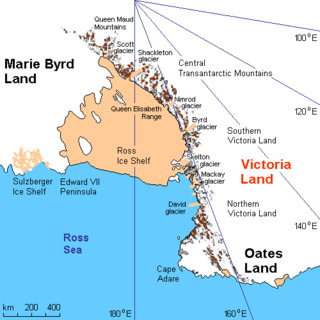
Cape Adare is a prominent cape of black basalt forming the northern tip of the Adare Peninsula and the north-easternmost extremity of Victoria Land, East Antarctica.
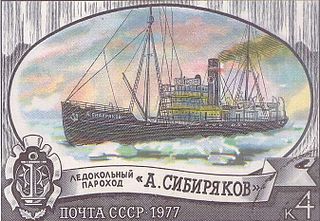
Alexander Sibiryakov was a steamship that was built in Scotland in 1909 as Bellaventure, and was originally a seal hunting ship in Newfoundland. In 1917 the Russian government bought her to be an icebreaker. She served the RSFSR and Soviet Union until 1942, when she was sunk by enemy action. The ship gave notable service in the Russian Arctic during the 1930s.

Farthest South refers to the most southerly latitude reached by explorers before the first successful expedition to the South Pole in 1911.

The Southern CrossExpedition, otherwise known as the British Antarctic Expedition, 1898–1900, was the first British venture of the Heroic Age of Antarctic Exploration, and the forerunner of the more celebrated journeys of Robert Falcon Scott and Ernest Shackleton. The brainchild of the Anglo-Norwegian explorer Carsten Borchgrevink, it was the first expedition to over-winter on the Antarctic mainland, the first to visit the Great Ice Barrier—later known as the Ross Ice Shelf—since Sir James Clark Ross's groundbreaking expedition of 1839 to 1843, and the first to effect a landing on the Barrier's surface. It also pioneered the use of dogs and sledges in Antarctic travel.

William Colbeck was a British seaman who distinguished himself on two Antarctic expeditions.

Nicolai Hanson was a Norwegian zoologist and Antarctic explorer. Nicolai Hanson was a member of the Southern Cross Expedition led by Carsten Borchgrevink to Antarctica and he became the first person to be buried in Antarctica.

Per John Savio was a Norwegian polar explorer and dog sled driver. As a member of the Southern Cross expedition 1898–1900, Savio together with Ole Must were the first to overnight on the Antarctic continent. He was also part of the sled team who were the first persons to travel on the Ross Ice Shelf and reaching a new Farthest South record.

SS Stephano was a passenger liner and sealing ship, owned by Bowring Brothers and operated in their Red Cross Line of Arctic steamships. Stephano is most notable for her role in the 1914 Newfoundland Sealing Disaster, under the command of Captain Abram Kean. Stephano was the sister ship to the SS Florizel.




















